Freedom Planet
| Freedom Planet | |
|---|---|
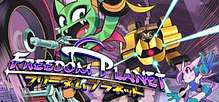 Steam storefront artwork | |
| Developer(s) | GalaxyTrail |
| Publisher(s) | GalaxyTrail |
| Composer(s) |
|
| Engine | Clickteam Fusion |
| Platform(s) | |
| Release |
Microsoft Windows
|
| Genre(s) | |
| Mode(s) | Single-player |
Freedom Planet is a 2D platform video game developed and published by GalaxyTrail, a studio set up by designer Stephen DiDuro. The player controls one of three anthropomorphic animal protagonists: the dragon Lilac, the wildcat Carol, or the basset hound Milla. Aided by the duck-like Torque, the player attempts to defeat Lord Brevon, who plans to conquer the galaxy. While the game focuses on fast-paced platforming, its levels are interspersed with slower action scenes.
Freedom Planet began development as a Sonic the Hedgehog fangame, but DiDuro lost interest in creating a derivative work and reconceived the project as his own intellectual property. He visited the website DeviantArt to recruit artist Ziyo Ling, who replaced the existing cast of characters with her own. Lilac, originally a hedgehog, became a dragon; antagonist Doctor Eggman was replaced by Brevon; and the Sonic series' ring-based health system was abandoned. Further changes were suggested by fans and incorporated throughout development. Freedom Planet was developed in Denmark and the United States and its art direction has East Asian influences: its background visuals were inspired by medieval Chinese art, and the game's title is written in katakana.
The game was released for Microsoft Windows, first as a demo in August 2012, then, after a successful Kickstarter campaign, as a full game via Steam in July 2014. The game was later released on the Wii U in October 2015, on the PlayStation 4 in 2017, and on the Nintendo Switch in August 2018. Freedom Planet has been widely compared to the early Sonic games. Critics praised its gameplay, aesthetics, and balance of Sonic elements with original content, but were mixed on its pacing and length. A sequel, Freedom Planet 2, will be released in 2019.
Gameplay
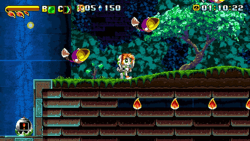
Freedom Planet is a 2D platform and action game featuring anthropomorphized animal characters and 16-bit style graphics mimicking the look of games released for the Sega Genesis, particularly the Sonic the Hedgehog series.[1][2][3][4][5] The game puts players in the role of one of the available playable characters as they traverse each level, fighting enemies and obstacles before facing a boss at the end. Players have a health meter, which can be replenished by collecting red leaves, and a regenerative energy meter used to perform each character's unique special moves. Players can earn extra lives by collecting blue crystals found throughout the level, or by rescuing creatures trapped in cages. Players can also obtain various types of shields, some of which often bonus attributes such as invulnerabilty to fire or the ability to breathe underwater, and invincibility power-ups. Cards are hidden through the levels, which unlock bonus content such as music and concept art, and bonus tokens which allows access to a bonus game at the end of the level.[6][7]
The game has three playable characters that are the protagonists: Lilac, Carol, and Milla. Each character has Melee attacks and a unique array of moves which allow them to traverse the environment in different ways. Lilac can perform a double-jump attack and can launch herself into an air dash, allowing her to bounce off walls and reach high areas. Carol is able to curl into a spin-attack while running and can climb up walls. By picking up gas canisters, Carol can bring out her motorcycle, which can double-jump and ride up vertical walls. Milla can throw gelatinous cubes and put up an offensive shield, combining the two to perform a Shield Blast, and flap her ears to reach high areas.[2][8]
Players can play through the main game in one of two ways; Adventure, which tells the game's story through the perspective of a chosen character, and Classic, in which the levels are played in order without any story cutscenes. Time Attack mode allows the player to attempt to complete levels in the quickest time possible.[9]
Plot
The game begins as Sash Lilac and Carol Tea—an anthropomorphic dragon and wildcat —rescue a duck-billed creature named Torque after his spacecraft crash lands. At Torque's request, the three set out to protect a powerful relic called the Kingdom Stone. This involves them in a conflict between three nations on their planet: Shuigang, a country militarized by its new king, Dail; Shang Mu, led by the wealth-obsessed Mayor Zao (/ˈzaʊ/ or /ˈʒaʊ/); and Shang Tu, whose Royal Magister is unprepared for war.[10] Lilac and Carol rush to the Kingdom Stone's shrine but are waylaid by the Shang Tu officers General Gong and Neera Li, who doubt that the Stone is threatened. The protagonists arrive just as the Stone is stolen by Spade, a henchman of Zao. After the shrine collapses, Carol is separated from Lilac and pinned by rubble, but she is saved by the timid basset hound Milla (/ˈmiːlə/) Basset.
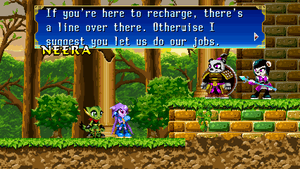
That night, Torque tells Lilac, Carol, and Milla that he is an alien sent to apprehend the intergalactic warlord Arktivus Brevon, whose spacecraft wrecked on the planet. Brevon has invaded Shuigang, murdered its king, and brainwashed Dail to be his servant. He intends to steal the Stone to power his ship. The protagonists decide to reclaim the Stone from Zao, but they are accosted en route by Spade and by Brevon's assistant Serpentine. The delays give Dail and Brevon's forces time to steal the relic. Afterwards, Zao sends the protagonists as emissaries to Shang Tu to discuss an alliance against Shuigang. They are detained by the Magister upon their arrival, as Neera blames them for the Stone's original disappearance. Torque is acquitted when Lilac falsely pleads guilty. She, Carol, and Milla quickly break out of jail to reunite with Torque, only to see him captured by Brevon and Serpentine.
Carol quarrels with Lilac and storms off. Lilac sends Milla to find her and then goes to save Torque from Brevon's nearby base, but she is captured and tortured by Brevon. Meanwhile, Carol and Milla ally with Spade to storm the base, where they rescue Torque and Lilac. They are all separated in the ensuing conflict. Neera finds Lilac, arrests her, and brings her back to Shang Tu, where the Magister determines that she is innocent and reveals that Zao is challenging Shuigang for the Stone. Lilac rejoins her friends and convinces Shang Mu and Shang Tu to unite against Dail and Brevon's army. During the battle, Brevon announces that his ship is repaired, and Lilac, Milla, and Carol board it. The team combats Brevon's minions, including a mutated Serpentine. Brevon captures Milla and turns her into a grotesque monster that attacks the other protagonists, who are forced to render her unconscious. Enraged, Lilac and Carol attack and defeat Brevon, but the Kingdom Stone is destroyed in the process. Shortly after the battle, Milla awakens in a medical tent and sees the sky lit up by swirling, crystalline energy released from the Kingdom Stone. The three kingdoms resolve to harness the Stone's power and share it equally, thereby bringing an end to the war. Torque says goodbye to Lilac, Carol, and Milla and returns to space.[10]
Development and release
—Stephen DiDuro[6]
Freedom Planet was conceived in late 2011 by American game designer and programmer Stephen DiDuro, who had just founded the independent development studio GalaxyTrail Games. Although it is an original intellectual property, Freedom Planet was first developed as a Sonic fangame: it contained rings, and Doctor Eggman was the villain. DiDuro decided that the Sonic affiliation would hold back the game and attempted without success to design his own characters. Afterward, he received permission from the Chinese artist Ziyo Ling—whom he had found on the art website DeviantArt—to use her character Sash Lilac, and later, Carol and Milla in his game.[6] The soundtrack was composed by DiDuro in collaboration with Shane "Blue Warrior" Ellis and user Leila "Woofle" Wilson.[11][5]
Early on, DiDuro got encouraged to separate it further from Sonic, so he replaced rings with red leaves and altered the characters' abilities.[6] Ziyo had drawn Lilac as a hedgehog, but DiDuro redesigned the character to be a dragon. Lilac's wall-bouncing was based on a similar game mechanic from Ristar. Originally, her level of energy was to be dependent on her speed, but this proved too difficult to control.[11]
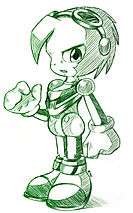
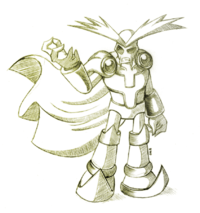
While Freedom Planet was developed in Denmark and the United States,[12] its art direction was influenced by medieval East Asian art,[8][9] particularly that of China.[13] The game's visuals reference modern science fiction and fantasy as well.[9] Much of the text in the game world is written in Chinese characters, and the title text is subtitled in Japanese katakana as Furīdamu Puranetto (フリーダム・プラネット), but the game originally did not support the Japanese language.[8]
Freedom Planet was first released as a demo for Microsoft Windows in August 2012.[2][4][5] After a full version of the game was funded through Kickstarter, it was taken to Steam Greenlight and approved for Steam.[14] Its release was first projected for early 2014,[5] then delayed to June 30.[13] Shortly before that date, it was delayed again to July 19: the developers wanted to promote the game at a convention in Miami, Florida, and to avoid competition from the heavily discounted products in Steam's Summer Sale.[15] The game was released, after a third delay, on July 21.[16] To advertise the game, GalaxyTrail created branded T-shirts,[14] and Lilac was included as an easter egg in the 2013 game Sonic: After the Sequel.[11] DiDuro considered and rejected the idea of developing an Android version of Freedom Planet, but he is saving money to port the game to the PlayStation Vita.[11] The game was released on the website GOG.com in late 2014.[17] GalaxyTrail also developed versions for Mac OS X and Linux, which were released on Steam on April 17, 2015.[18]
On March 9, 2015, Stephen DiDuro announced through Twitter that a version of the game for Nintendo's Wii U console was planned for release on the eShop online store for late 2015,[19][20] later specified as August 13.[21] A demo was released as part of a promotion titled "Nindies@home", wherein players were invited to try several upcoming Wii U games between June 15 and 22.[22] On July 28, GalaxyTrail confirmed that production of the final version of the game was taking longer than expected, suggesting that the game's release would be later.[21] DiDuro announced the cause of the delay on August 18: the Wii U version had been set back by a "console-freezing bug", which would postpone the Wii U release indefinitely until the issue was fixed.[23] He later explained that the bug had taken so long to detect because it only occurred in retail versions of the console, which had prevented GalaxyTrail and Nintendo from learning of the issue. The bug required a hard reset of the system to address the problem, which could potentially cause damage to the Wii U hardware.[24] The bug was eventually fixed, and the game was successfully released on the eShop on October 1; customers who had tried the game's demo were rewarded with a 15-percent discount.[25]
In November 2015, GalaxyTrail joined forces with the subscription box company IndieBox distribute an exclusive physical release of Freedom Planet. This limited collector's edition box included a flash-drive with a DRM-free game file, the official two-disc soundtrack, an instruction manual and Steam key, along with various custom-designed collectibles.[26][27]
Downloadable content (DLC) was created for the game. The first packs, which add Torque as a playable character and an adventure story for Milla, was released for computers in December 2015. An additional update to make Spade a playable character, was planned for release in 2016 but has been postponed.[28][29] A version for the Nintendo Switch will be released by Xseed Games on August 30, 2018.[30][31]
Reception
Prerelease
Tony Ponce of Destructoid reacted positively about the demo for Freedom Planet; and commented that it was "nice to see a well-established style or formula applied to a new world with original characters".[4] Similarly, Eurogamer's Jeffrey Matulef described the game's preview as "an indie Sonic-esque platformer done right", and enjoyed the redesigned health system.[2] Dominic Tarison of IndieStatik complimented the game's "new and unfamiliar configuration" of elements from classic 16-bit games, but criticised the amount of viewable gameplay area.[13] John Polson of IndieGames.com believed that "the spectacles like loops and wall runs ... [are not] as magical to do or watch" as in Sonic games, but he encouraged platformer fans to download the demo.[5]
Nathan Grayson of Kotaku praised the demo for its balance of Genesis Sonic elements and original content: he described the product as "a love letter to classic Sonic, except when it's not". He praised the game's enemies, but experienced minor control issues. Pacing was remarked to be slower than that of the Genesis Sonic games because of the added combat sequences, though Grayson felt that this gave the player time to explore and appreciate the level design. Grayson was critical of the voice acting.[3] Ponce strongly praised the visuals, though criticized the bland foreground design.[4] Polson noted minor audio and visual flaws, most notably the recycling of sound effects from Genesis Sonic games, but he lauded the game's music.[5] Tarison praised the music and visuals, as well as the varied designs of the environments and playable characters.[13]
Post-release
| Reception | ||||||||||||
|---|---|---|---|---|---|---|---|---|---|---|---|---|
| ||||||||||||
Reviewing the full version, Jahanzeb Khan of Hardcore Gamer felt that it was a worthy successor to the 1994 game Sonic 3 & Knuckles—which he considered the series' pinnacle—and that it was "perhaps the most Sonic game to have come out since 1994, one that feels like a true evolution and more importantly a resounding step forward."[9] Jonatan Allin of the Danish version of Eurogamer, who had not enjoyed any Sonic games since the Genesis era, concurred with Khan.[32] Polygon's Griffin McElroy argued that Freedom Planet successfully performs "a difficult balancing act, borrowing and transforming elements from games like Sonic the Hedgehog and Rocket Knight Adventures without coming off as derivative".[35] McElroy and Pablo Taboada of the Spanish-language website MeriStation both compared the game to the work of developer Treasure. Taboada lamented the game's obscurity and suggested that, had Treasure obtained the rights to Sonic and released Freedom Planet as an official sequel, it would have been more popular.[33][35]
Khan commented that the levels "never feel like they're over too soon nor do they drag on unnecessarily", and he appreciated the setpiece moments such as "explosive chase/escape sequences, maze like labyrinths, traps, and even shoot-'em-up style shooting segments".[9] Taboada was mixed on the game's brevity: he thought it was suitable for speedrunning but unsatisfying for those seeking a deeper experience.[33] By contrast, Japanese website 4Gamer stated that the game's quirks allowed one to play extensively without boredom,[8] and Taboada enjoyed the large, Metroidvania-style levels.[33]
Regarding the game's visuals, Taboada said, "Técnicamente es excelso" (technically, it is excellent). He praised the colorful and detailed backgrounds, expressive character animations, sound effects, and music.[33] Khan agreed: he commented that "every inch of it exud[es] artistic diversity with high resolution sprites that resemble the quality of yesteryear". He called the audio a "nice mix of catchy chiptune style melodies with infectious synthetic beats".[9] Both Khan and 4Gamer were intrigued by the game's East Asian visual style.[8][9] Taboada believed that each character was likeable and interesting to play.[33] Allin found himself unexpectedly captivated by the story, which he guessed many players would miss due to impatience with cutscenes.[32]
Sequel
On December 25, 2015, GalaxyTrail announced Freedom Planet 2 was in development. In contrast to the original title, it is being built using the Unity framework and has higher pixel art resolution than its predecessor. With the goal of "defin[ing] Freedom Planet's identity as a franchise", all characters from the game received design overhaul by Tyson Tan.[36] While the early concept artworks on the game's official website remain unchanged, Tyson had been experimenting new art style with the fans.[37][38] Christian Whitehead, who lead the development on Sonic Mania, will be involved with development as he will be helping DiDuro with programming, being responsible for porting over the physics from Clickteam Fusion over to Unity's engine.[39]
References
- ↑ Devore, Jordan (July 22, 2014). "Platformer Freedom Planet borrows from the Sega Genesis greats". Destructoid. Archived from the original on July 29, 2014. Retrieved August 17, 2014.
- 1 2 3 4 Matulef, Jeffrey (August 9, 2012). "Freedom Planet is an indie Sonic-esque platformer done right". Eurogamer. Archived from the original on July 14, 2014. Retrieved June 8, 2014.
- 1 2 Grayson, Nathan (July 25, 2014). "Freedom Planet Is Basically A Classic Sonic Game, Except When It's Not". Kotaku. Archived from the original on July 31, 2014. Retrieved September 2, 2014.
- 1 2 3 4 Ponce, Tony (August 8, 2012). "Sonic-inspired Freedom Planet tickles my platforming itch". Destructoid. Archived from the original on July 14, 2014. Retrieved June 8, 2014.
- 1 2 3 4 5 6 Polson, John (August 7, 2012). "Sonic the Hedgehog-Inspired Greatness: Freedom Planet Demo". IndieGames.com. Archived from the original on December 11, 2014. Retrieved June 8, 2014.
- 1 2 3 4 GalaxyTrail (August 12, 2012). "The Evolution of Freedom Planet". ModDB. Retrieved September 2, 2014.
- ↑ GalaxyTrail (July 21, 2014). Freedom Planet. GalaxyTrail.
- 1 2 3 4 5 "インディーズゲームの小部屋:Room#342「Freedom Planet」" (in Japanese). 4Gamer. July 30, 2014. Retrieved October 25, 2014.
- 1 2 3 4 5 6 7 8 Khan, Jahanzeb (November 11, 2014). "Review: Freedom Planet". Hardcore Gamer. Archived from the original on November 11, 2014. Retrieved November 11, 2014.
- 1 2 "Characters". GalaxyTrail. Archived from the original on June 25, 2014. Retrieved June 8, 2014.
- 1 2 3 4 GeneHF (July 15, 2014). "Retro Interviews: The Freedom Planet Invades Florida Supercon Edition". Sonic Retro (interview with Stephen DiDuro). Retrieved August 17, 2014.
- ↑ Galaxytrail. "Kevin Milligan on Twitter". Twitter. Retrieved January 17, 2016.
- 1 2 3 4 Tarison, Dominic (September 14, 2013). "First Impressions: Freedom Planet". IndieStatik. Archived from the original on July 15, 2014. Retrieved June 8, 2014.
- 1 2 Parisi, Vinny (June 4, 2014). "Freedom Planet T-Shirts Now on Sale!". IndieGameMag. Retrieved June 8, 2014.
- ↑ Strife (June 20, 2014). "Final Release Date Change – July 19th". FPBoards.net. Archived from the original on July 27, 2014. Retrieved July 18, 2014.
- ↑ "Freedom Planet – High Speed Platform Game". Kickstarter. July 18, 2014. Retrieved July 18, 2014.
We wanted to get the game up on Steam tomorrow, but, sadly, we have just learned that Steam does not release games on weekends. So although everything's good to go for our launch, we'll have to wait until Monday for our storefront to update. Hang in there for just a bit longer, folks!
- ↑ "Freedom Planet". GOG.com. Retrieved November 26, 2014.
- ↑ "Download". GalaxyTrail. Archived from the original on January 21, 2015. Retrieved January 21, 2015.
- ↑ Meli, Jowi (March 9, 2015). "Freedom Planet Bringing Its Brand of Sonic-Style Action to Wii U". Nintendo Life. Gamer Network. Retrieved August 29, 2015.
- ↑ Cardoso, Jose (August 3, 2015). "Freedom Planet coming to Wii U on August 13". GameZone. Retrieved August 29, 2015.
- 1 2 Whiethead, Thomas (July 28, 2015). "Freedom Planet is Speeding Onto the Wii U Soon". Nintendo Life. Gamer Network. Retrieved August 29, 2015.
- ↑ Khan, Jahanzeb (June 15, 2015). "E3 2015: Freedom Planet and More on Nindies@Home Program". Hardcore Gamer. Retrieved October 1, 2015.
- ↑ Latshaw, Tim (August 18, 2015). "Freedom Planet Release Bound by Bug". Nintendo Life. Gamer Network. Retrieved August 29, 2015.
- ↑ Latshaw, Tim (August 12, 2015). "Freedom Planet Runs into Delay". Nintendo Life. Gamer Network. Retrieved August 29, 2015.
- ↑ Carter, Chris (October 1, 2015). "Nintendo Download: Freedom Planet". Destructoid. Retrieved October 1, 2015.
- ↑ "Steam Community :: Group Announcements :: Freedom Planet". steamcommunity.com. Retrieved June 3, 2017.
- ↑ "The Freedom Planet IndieBox is the best yet - Geek.com". Geek.com. December 11, 2015. Retrieved June 3, 2017.
- ↑ "Freedom Planet DLC Announced". October 29, 2015.
- ↑ Seraphna. "State of the DLC". www.galaxytrail.com. Retrieved January 1, 2017.
- ↑ Reseigh-Lincoln, Dom. "Freedom Planet Is Officially Coming To Nintendo Switch This Autumn". NintendoLife.com. Retrieved 6 June 2018.
- ↑ Moyse, Chris. "Cute adventure Freedom Planet hitting Switch this month". Destructoid. Retrieved 10 August 2018.
- 1 2 3 Allin, Jonatan A. (August 15, 2014). "Freedom Planet – Anmeldelse" (in Danish). Eurogamer.dk. Archived from the original on November 2, 2014. Retrieved November 1, 2014.
- 1 2 3 4 5 6 Taboada, Pablo (August 1, 2014). "Freedom Planet" (in Spanish). MeriStation. Archived from the original on August 12, 2014. Retrieved August 11, 2014.
- ↑ Khan, Jahanzeb (3 January 2016). "Review: Freedom Planet". Destructoid. Archived from the original on 29 August 2016. Retrieved 17 March 2018.
- 1 2 McElroy, Griffin (June 26, 2014). "Freedom Planet – Overview video". Polygon. Retrieved August 11, 2014.
- ↑ "Freedom Planet 2 – Now in Development!". freedomplanet2.com. Archived from the original on July 11, 2017. Retrieved July 26, 2017.
- ↑ "Freedom Planet 2 Girls". DeviantArt. Retrieved July 26, 2017.
- ↑ "Freedom Planet 2 Girls ver 2". DeviantArt. Retrieved July 26, 2017.
- ↑ "Site Update for 2016 – Christian Whitehead". christianwhitehead.com.